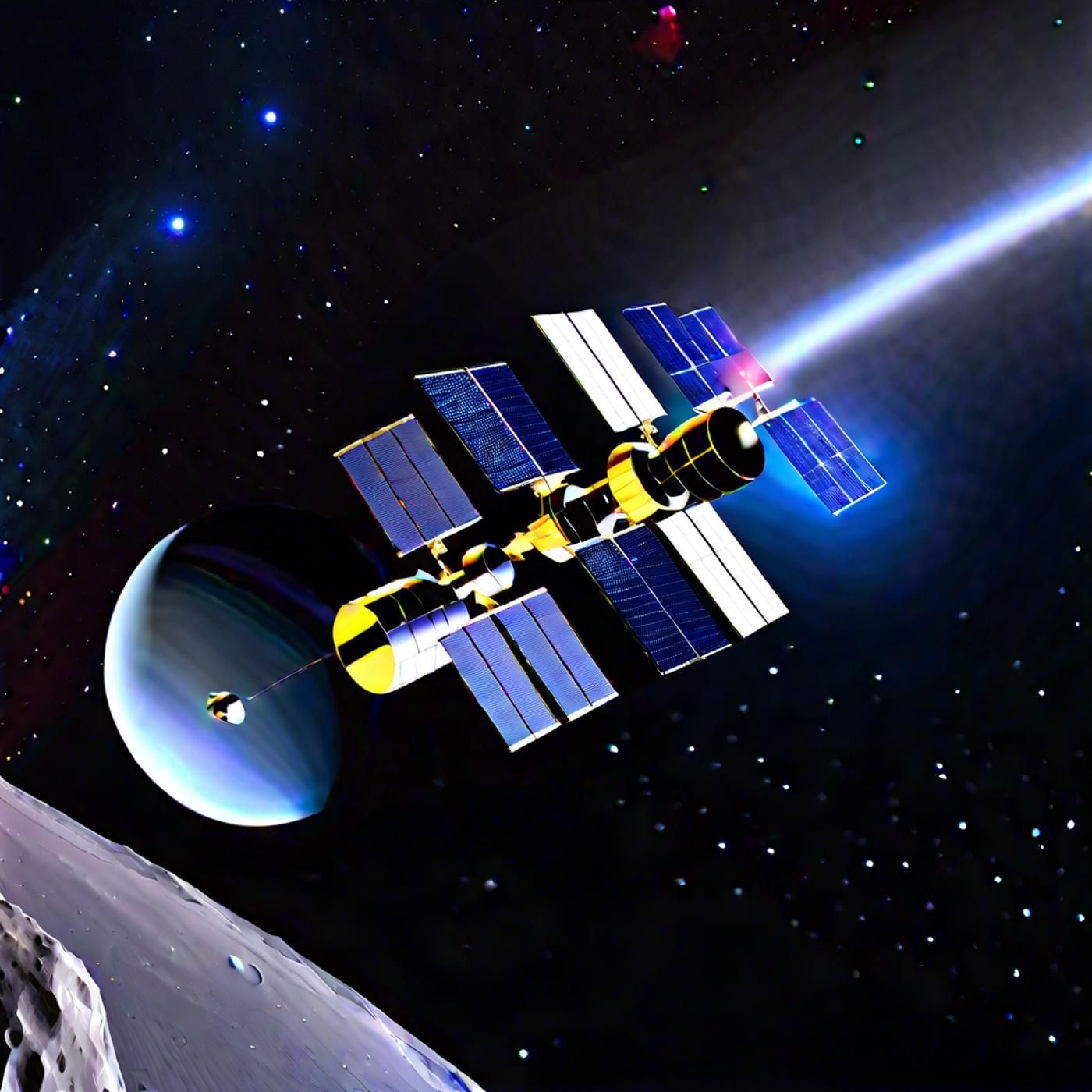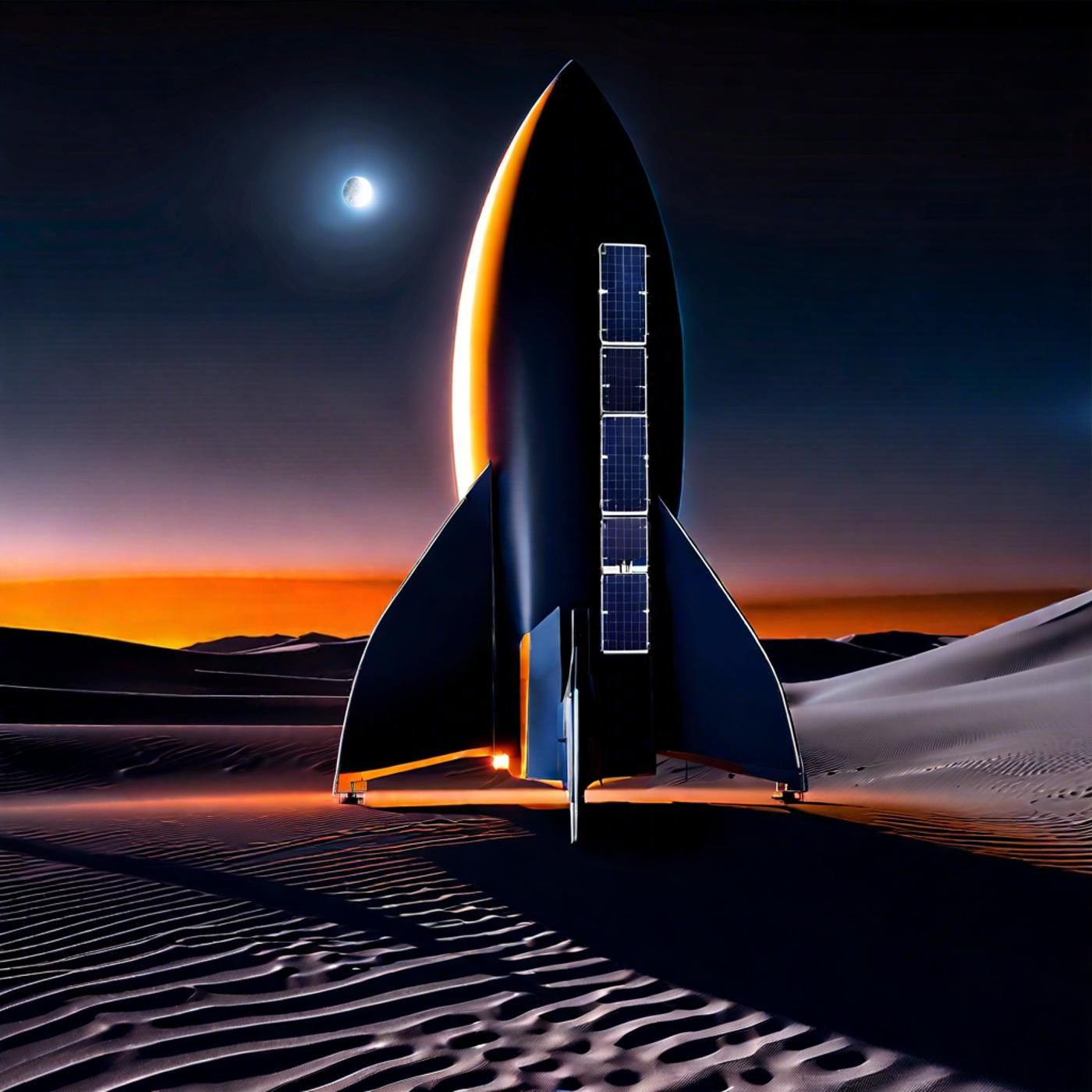S03E87: Starship's Tower Catch & ISS Debris Drama

Welcome to Astronomy Daily, the podcast that brings you the latest news in space and astronomy. I'm your host, Anna. Today we'll cover a variety of fascinating topics, including SpaceX's preparations for Starship flight five, a precautionary shelter...
Welcome to Astronomy Daily, the podcast that brings you the latest news in space and astronomy. I'm your host, Anna. Today we'll cover a variety of fascinating topics, including SpaceX's preparations for Starship flight five, a precautionary shelter event for astronauts aboard the International Space Station due to a satellite breakup, and NASA's Curiosity Mars rover facing a particularly prickly power puzzle. We have a lot of ground, or rather space, to cover today, so let's dive into the cosmos.
00:00 SpaceX gearing up for Starship flight five with possibility of tower catch attempt
02:46 Nine astronauts evacuated after Russian satellite fragmented, potentially creating hazardous debris
04:56 NASA's Curiosity rover has been hard at work on Mars, recently
09:28 Splashdowns have been a tried and tested method for spacecraft reentry
15:11 This podcast is available wherever you get your podcastsThank you for tuning into Astronomy Daily. I'm Anna, and I hope you enjoyed today's journey through some of the most exciting news and discoveries in astronomy and space exploration. Remember to visit our website at astronomydaily.io, where you can find regular updates on space news, access links to all the stories we featured today, and catch up on previous podcast episodes. We love bringing the wonders of the universe to your ears, and we appreciate your support and curiosity. Stay curious, keep exploring, and always look up. Until next time, take care and happy stargazing.
www.astronomydaily.io
www.bitesz.com
Become a supporter of this podcast: https://www.spreaker.com/podcast/astronomy-daily-the-podcast--5648921/support.
SpaceX gearing up for Starship flight five with possibility of tower catch attempt
Anna: Welcome to Astronomy Daily, the podcast that brings you the latest news in space and astronomy. I'm your host, Anna. Today we'll cover a variety of fascinating topics, including SpaceX's preparations for Starship flight five, a precautionary shelter event for astronauts aboard the International Space Station due to a satellite breakup, and NASA's Curiosity Mars rover. Facing a particularly prickly power puzzle, we have a lot of ground, or rather I space, to cover today, so let's dive into the cosmos. SpaceX is once again pushing the boundaries of what's possible in space exploration as it gears up for the fifth flight of its starship rocket, and excitement is building for what could be the first ever tower catch attempt. This potential milestone is a result of meticulous planning and rigorous testing, and it signifies another bold step toward the future of reusable spacecraft after the successful ocean soft landing during flight four, SpaceX is eyeing a tower catch for the upcoming mission. Elon Musk himself has expressed optimism on social media, hinting at a catch attempt for flight five. The US Federal Communications Commission's new communications license even alludes to either a soft ocean landing or a tower catch, adding more weight to the speculation. Booster 14.1 a test article has been rolled out to the orbital launch pad for rigorous stress tests. This truncated booster resembles the real hardware and is being used to simulate various aspects of the starship's landing mechanism, including interactions with the so called chopstick arms essential for catching the vehicle. In addition to the hardware tests, SpaceX is also revamping infrastructure at Starbase. Construction on a second orbital launch pad is underway, and upgrades to the existing tank farm and launch mount are being made to support increased launch activity. Even the orbital tank farm is receiving a capacity boost with the installation of new horizontal tanks, while older vertical tanks are being dismantled to make way for new infrastructure. The new launch pad is being built with lessons learned from the previous pad, featuring significant design upgrades, including more robust concrete pillars and improved mechazilla components. The ultimate goal is to support a higher tempo of launches, reinforcing SpaceX's vision of an integrated launch system that minimizes turnaround times between missions. Elon Musk has indicated that the goal is to fly flight five by late July, though delays could push the launch to August or even early September. Regardless of when it gets off the ground, starship flight five promises to be another thrilling chapter in the ambitious saga of reusability and space exploration.
Nine astronauts evacuated after Russian satellite fragmented, potentially creating hazardous debris
Nine astronauts aboard the International Space Station ISS recently experienced a tense moment when they had to take shelter in their docked return spacecraft. This precautionary measure came after a non operational russian satellite, ressers p one, fragmented in low Earth orbit, potentially creating hazardous debris. Shortly after 09:00 p.m. eDT on Wednesday, June 26, the crew moved into their three return spacecraft, including the Boeing Starliner. As a safety measure. NASA provided a brief update stating that the astronauts stayed in their spacecraft for about an hour before being cleared to exit and resume normal operations. During this incident, the ISS was reportedly in its sleep period, making the sudden evacuation even more disruptive. While NASA did not specify the exact satellite responsible, satellite monitoring firm Leo Labs confirmed that the event involved Rosseur's p one, a satellite that had been inactive since December 2021. US Space Command indicated that over 100 pieces of trackable debris were generated from the breakup, although they assessed no immediate threats to the ISS at the time. With the North American Aerospace Defense Command NORAD tracking over 45,300 space objects, the sheer volume of debris in orbit is becoming an increasing concern for space agencies worldwide. This incident underscores the persistent danger posed by space debris. NASA routinely collaborates with the us military to monitor potential hazards when debris comes uncomfortably close to the ISS. Within a region known as the pizza box, precautions such as moving the station or evacuating astronauts to their return spacecraft are taken. This pizza box area is a three dimensional space surrounding the ISS, extending roughly 2.5 by 30 by 30 miles. The recent shelter operation reflects the significant risk management challenges faced by space agencies. The frequency of such incidents underscores the need for effective debris mitigation strategies and international collaboration to ensure the safety of current and future space missions.
NASA's Curiosity rover has been hard at work on Mars, recently
NASA's Curiosity rover has been hard at work on Mars, recently, marking success with a drill operation at a site dubbed Mammoth Lakes two. The drill itself is only the beginning of a much more involved scientific exploration process, which includes analyzing the drilled material for its composition through various instruments on board the rover. One of these is the chemistry and mineralogy x ray diffraction instrument, known as cheminous, which has already begun its investigation. However, this scientific success brings its own set of challenges, particularly when it comes to power management. Curiosity relies on a finite amount of energy to conduct its various research activities, including environmental observations and remote sensing tasks. To continue its vital science operations, the mission team is meticulously planning how to allocate the rover's power for the upcoming weekend. The team has integrated environmental observations and remote sensing to maximize the scientific yield without exhausting the rover's power reserves. The plan includes using the laser spectrometer to analyze the drill hole and a series of short change detection observations on sites named Walker Lake and Finch Lake to monitor wind driven movements of martian sand. These observations, while crucial, require curiosity to be awake, consuming valuable power. Additionally, the team has adopted several strategies to conserve energy. They've prioritized environmental observations, classifying them by importance to ensure only the most critical tasks are performed. They've also shuffled the schedule to capitalize on times when the rover must be awake for other essential operations, reducing the overall impact on its power reserves. Despite these challenges, the team has managed to fit in a robust schedule of scientific tasks, including various mosaics from Masscam and Chemcam on previously studied targets. The rover also performed additional laser induced breakdown spectroscopy Lib's analyses on new targets, providing a wealth of data for researchers back on Earth. This careful planning ensures that even with limited power, curiosity can continue its exploration and deliver valuable scientific insights, driving forward our understanding of the martian landscape and environment. Utilizing regolith on Mars to provide essential resources is no longer just a concept it's rapidly becoming a viable reality, thanks to NASA's regolith advanced surface systems operations robot, or Rassor. This innovative technology is designed to excavate martian soil, known as regolith, to extract critical resources such as water and oxygen. The Rasa robot has been developed at NASA's swamp works akin to Lockheed Martin's skunk works, where cutting edge projects like the SR 71 Blackbird were conceived. RaSR, now in its second iteration, features a robust chassis, a powerful drivetrain, and two large bucket drum excavators. These excavators work on opposing sides of the rover, canceling out the horizontal forces that typically make digging machinery unwieldy and inefficient in Mars low gravity environment. What makes Rassor particularly groundbreaking is its ability to collect regolith rich in water content, even from Mars relatively dry regions. Martian soil samples suggest that around 2% of the regolith contains water. By collecting and processing the soil, Rassor could provide enough water for multiple applications, fueling rockets, supplying drinking water, and producing oxygen for astronauts, as well as for radiation protection and agriculture. The project envisions a mission where Rasor would mine up to 1 million regolith annually, supplying vital resources to sustain a crew of four astronauts. This would entail a rigorous schedule of about 35 soil collection trips per day, only taking a break to recharge batteries for 8 hours each day. The robots capacity to operate autonomously makes it a promising candidate for long term missions. While development of RasAr 3.0 is currently on hold, ongoing university led projects like the Lunabotics Challenge, ensure continuous advancements in regolith excavation technology. If picked up for further development, Rassor could be a cornerstone in realizing the dream of sustained human presence on Mars. This innovative robot isn't just advancing technology, it's bringing us one step closer to becoming an interplanetary species.
Splashdowns have been a tried and tested method for spacecraft reentry
Splashdowns have been a tried and tested method for spacecraft reentry since the early days of the space race. This technique combines the forces of atmospheric drag, heat shielding, and ultimately, the cushioning effect of a water landing to safely return astronauts and their spacecraft. Let's start with a historical perspective. On July 21, 1961, astronaut Gus Grissom became the second American to travel to space aboard the Liberty Bell seven capsule. The mission went smoothly until splashdown, when a malfunction caused the capsule's hatch to blow off prematurely. What followed was a dramatic scramble for survival as water began to flood the capsule and Grissom's spacesuit. Thankfully, he was rescued just in time by a Navy helicopter. But the capsule was lost. This harrowing event highlighted the inherent risks of splashdowns, but led to crucial improvements in safety measures and protocols. So how does splashdown work scientifically? When a spacecraft re enters Earth's atmosphere, it plummets at velocities several times the speed of sound, generating intense heat due to atmospheric friction. A robust heat shield protects the spacecraft from burning up, dissipating the heat through a process known as ablation, as it slows down considerably thanks to the atmosphere's drag. Parachutes are deployed to further reduce its speed. These massive chutes, often over 100ft in diameter, are brightly colored for visibility and provide the final deceleration needed before the capsule hits the water. Water landings are particularly effective because liquids, like the ocean, are excellent shock absorbers. Upon hitting the water, the kinetic energy of the spacecraft is rapidly dissipated, allowing for a relatively gentle impact compared to landing on solid ground. The splashdown velocity, typically about 80ft/second is slow enough to prevent structural damage while ensuring the payload and astronauts remain safe. Over the decades, advancements in technology and engineering have dramatically improved the safety and reliability of splashdowns. The tragic Challenger disaster in 1986 underscored the importance of robust crash worthiness criteria for all spacecraft. Nowadays, rigorous simulations and tests ensure that modern vehicles can withstand the stresses of both reentry and splashdown. Let's fast forward to current times. Between 2021 and June 2024, SpaceX's Dragon capsules have executed flawless splashdowns as they returned from the International Space Station. These controlled water landings not only exemplify engineering prowess, but also mark the reusability era in space exploration. SpaceX has even started recovering its rocket boosters through splashdowns, a, cost efficient practice that preserves key components for future missions. And speaking of modern feats, on June 6, 2024, SpaceX's starship, the most powerful rocket to date, made an awe inspiring vertical splashdown into the Indian Ocean. With its rocket boosters still firing upon landing, the site was nothing short of spectacular, creating an extraordinary cloud of steam around the rocket's nozzles. Splashdowns will continue to be a mainstay of safe spacecraft recovery as we push the boundaries of human space exploration. Their proven reliability, combined with advancements in technology, make them well suited for today's missions and those of the future, including potential Mars and moon ventures. Tune in next time as we track more exciting advancements in space exploration and scientific discovery. And remember, whether it's a historic tale or a state of the art technology, the splashdown continues to play a crucial role in bringing our astronauts safely home. Astrobotic has made waves with the unveiling of a high fidelity lunar testing ground in Mojave, California, designed to simulate the exact conditions of the moon. Named the lunar surface Proving Ground, or LSPG for short, this 330 by 330 foot test field replicates the lunar terrain and lighting conditions, particularly those found at the moon's south pole. Why is this so significant? For starters, the LSPG offers a realistic environment for testing precision landing technologies. Techniques that utilize lidar scanners can now be tested in conditions that mimic the challenges of actual lunar terrain. The same goes for rovers and other robotic systems that need to navigate and perform tasks on the moon's surface. Sean Bedford, the director of business development at Astrobotic, emphasized the groundbreaking nature of this facility, stating, our lunar surface proving ground stands out as the most realistic test field of this scale, modeled directly from a lunar surface map anywhere in the world. This makes it a critical asset not only for commercial enterprises and governmental agencies, but also for academia, as they all work together to develop capabilities that can be extended from the moon to Mars. The LSPG's debut was marked by NASA's 2023 to 2024 Techrise Student Challenge, where 30 student teams had the opportunity to fly experiments over this simulated lunar landscape using astrobotics zodiac reusable vertical takeoff vertical landing rocket. This collaborative effort showcases how the testing ground can serve as a hub for innovation and education. Even with the setback of their peregrine lunar lander, which faced anomalies post launch and re entered Earth's atmosphere astrobotic remains focused on future missions. The forthcoming launch of their larger Griffin lander later this year is a testament to their determination and the crucial role the LSPG will play in refining technologies before they make the journey to the moon.
This podcast is available wherever you get your podcasts
That's it for today's episode of Astronomy Daily. I'm your host, Anna. Be sure to visit our website at astronomydaily IO, where you can access all our back episodes. Sign up for our free daily newsletter, and read the latest space and astronomy news in our constantly updating news feed. Don't forget to subscribe, rate, and share our podcast, Astronomy daily. The podcast is available wherever you get your podcasts, including Spotify, Apple Podcasts, YouTube Music, music, and iHeartRadio. Please support our sponsors who help us keep the lights on, including NordPass, NordVPN, Protonmail, and Amazon. Links to their special offers are available on our website. See you next time.
New to Astronomy Daily - The Podcast?
Here are some great episodes to start with.




















